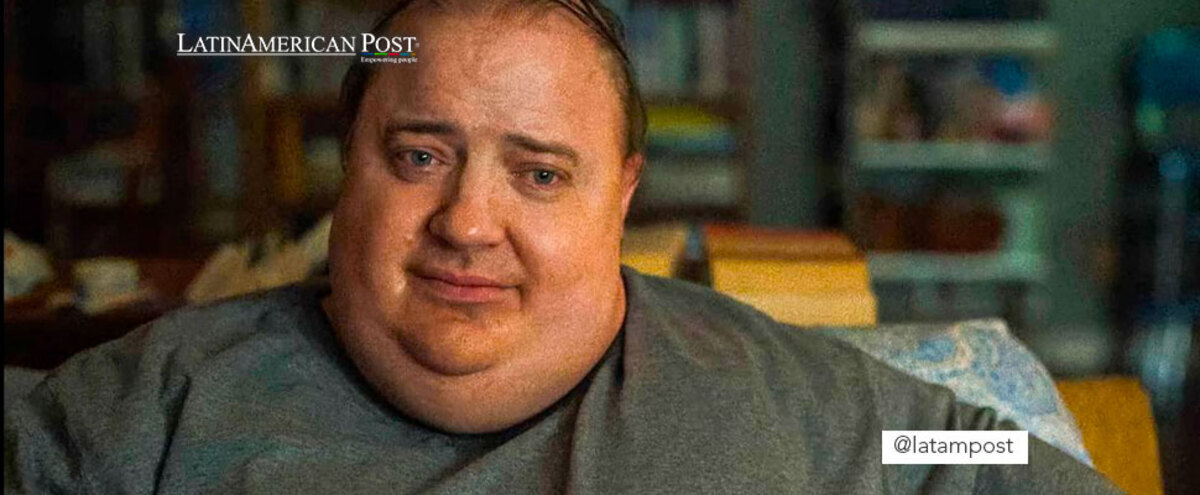Review of “The Whale”: Redemption in the Midst of a Storm of Guilt
Nominated for three Oscars, Darren Aronofsky's new film reminds us of the value of forgiveness and love in a world mired in chaos and pain. This is our review of "The Whale".

Photo: YT-A24
LatinAmerican Post | Jose Arnold López Hernández
Escucha este artículo
Leer en español: Reseña de “La Ballena”: redención en medio de una tormenta de culpas
Darren Aronofsky's filmography has been made up of characters broken by guilt, the social environment and their own ego, who at some point find their climax in hope, love, or forgiveness. For him, the transformation of the character is revealed at its lowest point, thus showing his humanity in a direct and heartbreaking way.
"The Whale" introduces us to Charlie (Brendan Fraser), a lonely, morbidly obese English teacher who has a particular appreciation for an essay on "Moby Dick." After suffering a heart attack, he tries to seek forgiveness from Ellie (Sadie Sink), his daughter, whom he abandoned when she was eight years old.
With this premise, Aronofsky (“Requiem for a Dream”, “The Black Swan”) delves into the fragility and pain of a person who lives with resentment about himself, to the point of taking refuge in food as his only relief. The way the story is developed is forceful, and even cruel with its different characters, but it does not forget to humanize them. It makes the viewer reflect on the ability to love and forgive. “The Whale” is not only a story about the chaotic nature of connecting with others in modern times, but also about the importance of redemption and the legacy we leave behind.
Of Grudges and Disconnections.
Samuel D. Hunter adapts his play “The Whale” to film with an appropriate pacing that allows the relationships between the characters to flow. Narrated over the period of a week, we are spectators of Charlie's messy and gloomy life, who must make decisions that affect his life and that of the few people around him. Meanwhile, we learn about the guilt that each one carries in their hearts. No scene feels unnecessary as we empathize and understand each internal struggle.
The uncertainty that Aronofsky and his team capture, with genius, ranges from the organization of the books or the choice of food and furniture to what the protagonists see on television. Characters such as Liz (Hong Chau), a nurse and Charlie's best friend, who cares for and accompanies him despite witnessing his self-destruction, and Thomas (Ty Simpkins), a young man who seeks to convert Charlie to “New Life” stand out in order to save someone's soul and redeem himself in this way. Their interactions are not just emotional and physical support for Charlie, but also a challenge to themselves because of their religious past. Both Liz and Thomas carry remorse for the decisions they have made, and despite their differences, they find a refuge in Charlie to be better and make sense of their pain.
Charlie's attitude towards his help, understanding, and compassion is humble and charismatic, despite how imposing the character appears, an effect achieved thanks to the detailed work of makeup and prosthetics. Thus, Aronofsky achieves a balance between the grotesque and the sensitive that his protagonist can show off. In addition, it adds elements that make Charlie's interaction with his environment feel a glimmer of hope and, above all, an understanding of his physical and mental state. Charlie is not a biblical monster as society wants to paint him, but someone who has been carried away by sadness and the lack of connection with reality.
Read also: Review of "The Banshees of Inisherin": Existential Crisis on an Irish Island
Faith Will Set Us Free
Aronofsky and Hunter are not afraid to point out the inconsistencies and hypocrisies of religion as a method of salvation and redemption. In addition, they also criticize the superficiality of society in the face of health problems. Charlie, played with a lot of character by Brendan Fraser, does not seek salvation in the eyes of society, the divine or those he loves, but in his own eyes and those of his daughter.
The “Moby Dick” essay is taken up throughout the film as an analogy for Charlie's sadness, struggle, and hope for the world, which he will later place in his daughter. Ellie thus becomes a counterpoint for all the characters. From the coldness that she shows in her social networks, her attitudes, and her vocabulary, she allows everyone to recognize themselves and accept their reality, and even that they can leave their past behind. The characters manage to move forward with what they need more than what they want, thanks to their connection, their love, and their faith in others.
“ The Whale” is a difficult melodrama to watch because of the position that Aronofsky takes on his character, since he confronts the viewer at every moment both visually and narratively to the limit. The film wonders about how the peak of love and forgiveness lies in the memories and in the sincerity of those who accompany us and accept us, but also about how we detach ourselves from the emotional. Charlie's story is a beacon of hope about what it means to be human, but also about how complex it can be to connect with ourselves and our feelings.




